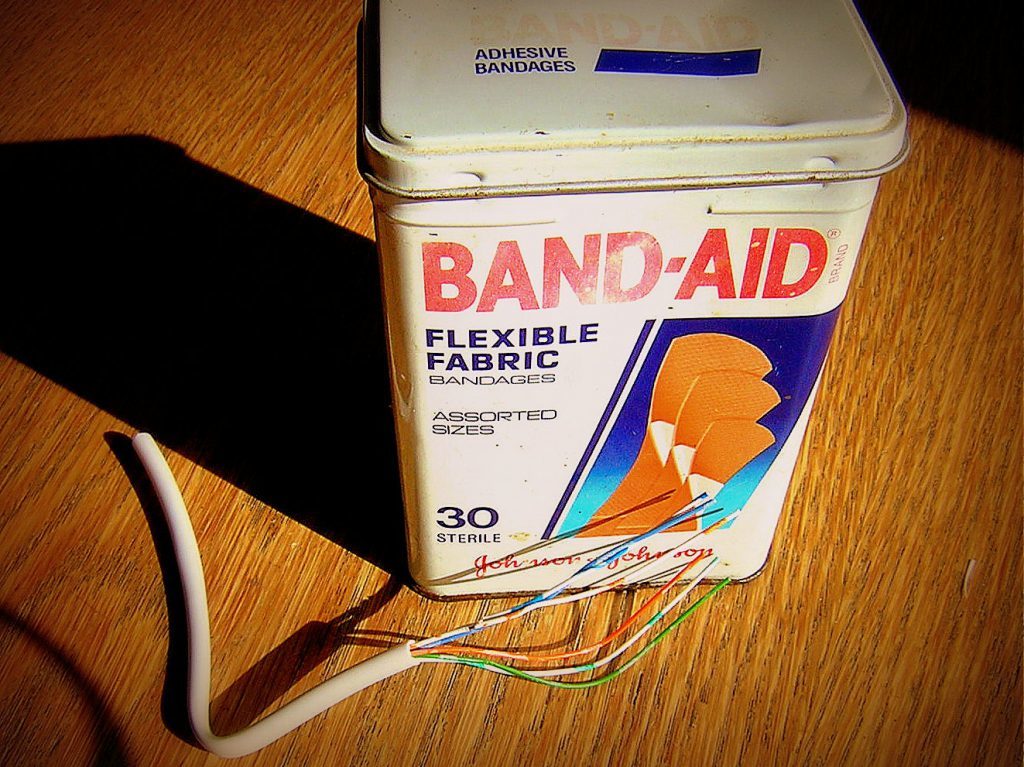Because telephone wires (the ones that connect your phones to the master socket in your house) are so small, people don’t seem to take phone wiring repair very seriously. The result is that people struggle to make even the most embarrassingly messy and unreliable connections.
However, there are some easy steps to follow, using easily-available equipment, that can make phone wiring repair easier. It isn’t that hard with the right stuff.
I encounter faults from bad phone wiring repair very often. It keeps me in business. But here are some “trade tips”;-
First, The Bad News – What Doesn’t Work…
Twist and Tape. Nope. This results in the cables eventually snapping due to bending stress, or corroding. To cover the taped joints involves a bandage of tape the size of a child’s little finger. Far too bulky. Then the tape dries out and falls off. Finally, if exposed to damp, the cable corrodes and causes problems…. Take a look at this horror photo…
Mains Wiring Block Terminals? The plastic things with screw tops. Either they are too big, and don’t grip the cable, or too small and too fiddly to fit. They are nowhere near as quick and effective as “punch-down” connectors. They look ghastly.
Car-Type Bullet Connectors. Actually, BT used to use something very similar to these, but they still need to be of good quality and have the correct tool to work well. They need to be crimped up correctly. Possible but not advisable. There are better ways to effective phone wiring repair
Solder. Well, if you have the patience… But you still have to insulate the joint with something.
So, I’ve seen almost all of these type of phone wiring repair fail. Or, even worse, when you come to work on them, putting them right takes a long, long time. The customer thinks you’re from “Mr Bean Telecom” because you are taking so long over one tiny joint or box. If only they knew…
Now, The Good News – What works?
An “in-line connector block” (“BT 78A”) like this:-
They use the same connectors as a typical phone socket, that is of the “punch-down” type. This pushes the cable into a sharp metal “V”, strips the insulation (and holds the wire firmly in place at the same time). It makes positive electrical contact. You need to use a special tool to do this. A screwdriver, or anything else will bend the prongs of the “V”, and render the connector useless. They are commonly available on Amazon, eBay, Maplin or similar, often known under their BT part code “BT 78A” There’s also the “BT80A” which incorporates screw terminals at one side.
What else works?
Well, if you have somewhere to hide them, jelly-filled Scotch crimps (sounds like something from a Burns Night Supper…) are ideal.
For a professional telephone engineer, they are an absolute phone wiring repair “life-saver”. If your DIY customer has cut cable too short in a socket, they can be used as a very quick and compact way of extending a wire. Again, these are available on-line. They work on a similar principle to the BT 78A (above), except you simply poke the wires all the way in, then squeeze with some pliers, or a special tool. That’s it! BT street cabinets are full of them. I love them!
They can be hidden inside things, such as sockets, trunking, conduit. They can also be used to connect things back together very quickly in order to get phone/internet working while you think of a longer-term fix.
And something else…
The obvious fix. You might want to carry out phone wiring repair by actually replacing a run of cable between, say, a BT master socket and an extension socket. It’s actually often quicker to replace a full run of cable than mess around jointing in highly visible/vulnerable places.
A quick note regarding your master socket. If you plan to move it (illegally), use one of the “bodge” methods, and Openreach come to your house and spot it, then they are likely to charge you in order to put it right, and for the trouble of coming to your house to fix a fault that (technically) you have created on their network. I’ve written a short case study here
If you are going to do this (and of course you shouldn’t), then at least use some professional-standard connectors. Anything else just screams “DIY”. And will fail.
There’s not a great mystery to phone wiring repair – it’s not hard to find the proper components, do it right, keep yourself connected, and telephone engineers like me away from your door.
Help is At Hand
But if you do get stuck, and you’re not far from me, that is close to Middlesbrough, Stockton on Tees, Darlington, Co. Durham and North Yorkshire, drop me a line!. Plus, I’m in touch with many engineers across the UK. All I ask in return is some favourable feedback on my Facebook Page or a Google review.
